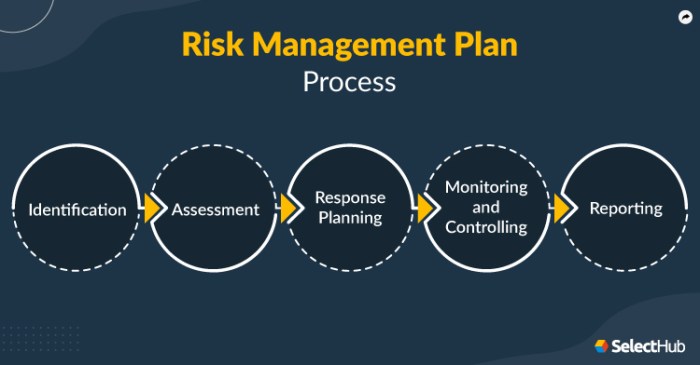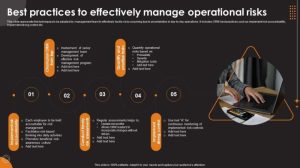
Embark on the journey of creating a solid risk management plan with this detailed guide, diving into key strategies and insights to effectively mitigate risks.
Risk Assessment

When developing a risk management plan, conducting a thorough risk assessment is crucial to identify and address potential risks that could impact the organization. By assessing risks upfront, businesses can proactively mitigate these threats and prepare contingency plans to minimize their impact.
Key Elements of Risk Assessment
- Identification of Potential Risks: The first step in risk assessment involves identifying all possible risks that could affect the organization, including internal and external factors.
- Evaluation of Risks: Once risks are identified, they must be assessed in terms of their likelihood and potential impact on the business operations.
- Prioritization of Risks: Not all risks are equal, and it is essential to prioritize them based on their severity and likelihood to occur.
- Risk Analysis: Analyzing the root causes and consequences of each risk can help in developing effective risk management strategies.
- Risk Documentation: Documenting the findings of the risk assessment process is crucial for reference and future planning.
Methodologies for Risk Assessment
- Quantitative Risk Assessment: This method involves assigning numerical values to risks based on probability and impact, allowing for a more data-driven approach.
- Qualitative Risk Assessment: Qualitative assessment focuses on identifying and analyzing risks based on their qualitative characteristics, such as reputation damage or regulatory issues.
- Scenario Analysis: This method involves creating hypothetical scenarios to assess how different risks could impact the organization and develop response strategies accordingly.
- Hazard Identification: Hazard identification involves recognizing potential hazards within the organization’s processes, operations, or environment that could lead to risks.
Risk Management Plan Overview
A risk management plan is a structured approach that helps organizations identify, assess, and prioritize risks that could potentially impact their operations. The purpose of a risk management plan is to minimize potential threats and maximize opportunities, ultimately ensuring the organization can achieve its objectives effectively.
Typical Structure of a Risk Management Plan
A typical risk management plan consists of the following key components:
- Risk Identification: This involves identifying all potential risks that could affect the organization.
- Risk Assessment: After identifying risks, they are assessed based on their likelihood and impact.
- Risk Mitigation: Strategies are developed to reduce the likelihood of risks occurring and minimize their impact if they do.
- Risk Monitoring: Continuous monitoring of identified risks to ensure the effectiveness of mitigation strategies.
- Risk Communication: Effective communication of risks and mitigation strategies to stakeholders.
Tools or Software for Effective Risk Management Plans
There are various tools and software available to help organizations create and manage risk management plans effectively. Some examples include:
- Enterprise Risk Management (ERM) software: ERM software provides a comprehensive platform to identify, assess, and manage risks across an organization.
- Risk Assessment Tools: These tools help in assessing and prioritizing risks based on predefined criteria.
- Project Management Software: Some project management software includes features for risk management, allowing teams to track and mitigate risks throughout a project’s lifecycle.
Risk Tolerance

Risk tolerance refers to an organization’s willingness to accept and manage risks in pursuit of its objectives. It is a crucial aspect of risk management as it helps in determining the level of risk that an organization is comfortable with and can afford to take.
Significance of Risk Tolerance
Determining risk tolerance is essential as it allows organizations to align their risk management strategies with their overall goals and objectives. By understanding their risk tolerance, organizations can make informed decisions regarding which risks to accept, mitigate, or transfer.
- It helps in setting risk management priorities and allocating resources effectively.
- It enables organizations to maintain a balanced approach towards risk-taking, ensuring they do not expose themselves to unnecessary risks.
- It provides a framework for evaluating the potential impact of risks on the organization’s performance and reputation.
Strategies for Determining Risk Tolerance
Organizations can determine their risk tolerance through various strategies, including:
- Conducting risk assessments to identify potential threats and vulnerabilities.
- Engaging key stakeholders to understand their risk appetite and tolerance levels.
- Reviewing historical data and industry benchmarks to assess the organization’s risk exposure.
It is essential for organizations to regularly review and update their risk tolerance levels to adapt to changing business environments and emerging risks.
Influence of Risk Tolerance on Decision-Making
Risk tolerance directly impacts decision-making within an organization by guiding leaders in determining the acceptable level of risk for pursuing opportunities or addressing challenges. It influences decisions related to investments, project planning, resource allocation, and strategic initiatives.
- High risk tolerance may lead to more aggressive strategies aimed at achieving rapid growth or innovation.
- Low risk tolerance may result in conservative approaches focused on stability and risk mitigation.
- Balancing risk tolerance with organizational objectives is crucial for making informed and effective decisions.
Risk Mitigation Strategies
When it comes to managing risks, organizations need to have effective mitigation strategies in place to minimize the impact of potential threats. These strategies help in reducing the likelihood of risks occurring and their potential consequences.
Common Risk Mitigation Strategies
- Risk Avoidance: Involves taking actions to completely avoid the risk by eliminating the root cause.
- Risk Transfer: Involves transferring the risk to a third party, such as through insurance or outsourcing.
- Risk Reduction: Focuses on reducing the probability or impact of the risk through preventive measures.
- Risk Acceptance: Acknowledging the risk and its consequences, choosing to accept it without any action.
Proactive and Reactive Risk Mitigation Approaches
- Proactive Approach: Involves taking preventive measures to address risks before they occur, such as conducting regular risk assessments and implementing controls.
- Reactive Approach: Involves responding to risks after they have occurred, such as developing contingency plans and crisis management strategies.
Importance of Regularly Reviewing and Updating Risk Mitigation Strategies
Regularly reviewing and updating risk mitigation strategies is crucial for maintaining their effectiveness. As the business environment evolves, new risks may emerge, and existing risks may change in nature. By regularly reviewing and updating mitigation strategies, organizations can ensure that they remain relevant and aligned with current risk profiles. This helps in enhancing the overall resilience of the organization and ensures that it is better prepared to manage any potential threats that may arise.
In conclusion, mastering the art of risk management planning is essential for any organization looking to navigate uncertainties successfully and make informed decisions.
Question & Answer Hub
What is the importance of conducting a risk assessment before developing a risk management plan?
Conducting a thorough risk assessment helps in identifying potential risks and developing strategies to mitigate them effectively.
How does risk tolerance influence decision-making within an organization?
Risk tolerance dictates how much uncertainty an organization is willing to handle and impacts the choices made in managing risks.





